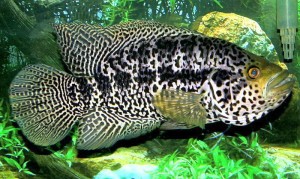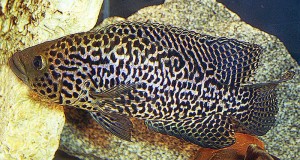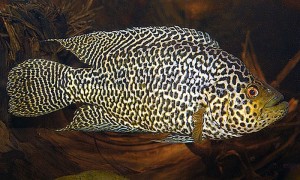The Managuense Cichlid (Parachromis managuense) is a large Central American species that is also known to tropical fish keeping enthusiasts as the Jaguar Cichlid or Aztec Cichlid. The species was originally found in Lake Managua, Nicaragua where it got its name but is distributed throughout Central America from Honduras to Costa Rica.
The Jaguar or Managuense Cichlid, is a beautifully marked, carnivorous, highly predatory species that prefer turbid, eutrophic lakes, and are often found in warm, oxygen depleted waters. They are usually found over mud bottoms at depths of 10 to 33 feet, but can also be found in sandy bottomed ponds and springs that are covered with plant debris.
Young Managuense Cichlids have a dull silver to gold body with dark black spots that run along the entire length of the fish. As they mature, the drab blotches on the body become darker and eventually turn into an irregular black pattern that resembles a Jaguar’s color pattern.
Adult Managuense Cichlids have a background body color that is pearly yellow/bronze, with a light purple cast, scattered with vivid black spots that occur all along the flanks and gill plates of the fish. The large black irregular shaped pattern runs horizontally along the lateral line and the fins are usually dark to black in color, especially during spawning. Males are generally larger, more brightly colored and have pointed dorsal and anal fins.
Although females are similarly colored, they are generally smaller than the males, less colorful, and lack the elongated extensions to the dorsal fins.
The red pigmentation in females during spawning is significantly more prominent in the gill plate area.
Juvenile Managuense Cichlids should be housed in at least a 55 gallon aquarium with a coarse gravel substrate, enough rocky structures for them to hide among, some driftwood and plenty of swimming space. Hardy, potted plants
can be added but these fish tend to burrow in the substrate and will quickly tear up plants.
Although Parachromis managuense are predators, they can be housed with other large South American Cichlids however, they may become aggressive with cichlids that are similar in color to them. It is best to keep breeding pairs of Managuense Cichlids, or any other member of the Parachromis, separate unless the tank is a very large one. Breeding pairs become hyper aggressive and will become a danger to any other species in the tank. Under no circumstances should they be kept with any fish that could possibly fit into their mouths.
Managuense Cichlids are excellent parents, form nuclear families, and are easy to breed in an aquarium environment. Place a breeding pair in a tank with several pieces of slate or flat rocks and little other decorations. The male will begin to court the female by displaying his erect fins. When she accepts his invitation, the pair will begin to clean a flat surface where she will lay up to 5,000 yellowish orange eggs.
The usual spawn is between 1000–2000 eggs and when fertilized by the male, usually hatch within 5 to 7 days. The fry (called wrigglers) are fiercely guarded by the parents and moved between pits that were previously dug by them. The fry will be free swimming in approximately 7 days and can be fed baby brine shrimp until they are able to eat Daphnia, blood worms, and other live foods.
At this stage, if you would like to keep more of the fry, remove them from the tank and transfer them in a rearing tank. The parents will consume the fry when the female is ready to spawn again if they are left with the parents.
In their natural habitat, Managuense Cichlids feed on small fish and invertebrates. In an aquarium environment, they are not fussy eaters and will readily accept almost anything offered. A varied diet of live, frozen or freeze dried fish, prawn, bloodworms, mysis shrimp, tubifex, insects, crickets, small earthworms, or even chopped lean meat mixed with Cichlid pellets will keep them healthy. To minimize the potential of disease, “feeder fish” should be offered only sparingly.
Managuense Cichlids are usually available to tropical fish keeping enthusiasts at a size of 1″ to 1-1/2″.
Minimum Tank Size: 55 gallons
Care Level: Moderate
Temperament: Aggressive
Aquarium Hardiness: Hardy
Water Conditions: 70-75° F, KH 4-10, pH 6.0-7.5
Max. Size: 1′ 6”
Color Form: Black, White, Yellow
Diet: Omnivore
Compatibility: Single species
Origin: Costa Rica, Honduras, Nicaragua
Family: Cichlidae
Lifespan: 15 years
Aquarist Experience Level: Intermediate




